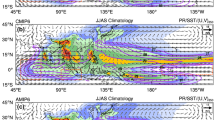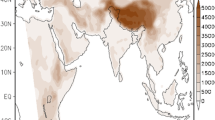Abstract
Seasonal prediction of Indian Summer Monsoon (ISM) has been attempted for the current year 2011 using Community Atmosphere Model (CAM) developed at the National Centre for Atmospheric Research (NCAR). First, 30 years of model climatology starting from 1981 to 2010 has been generated to capture the variability of ISM over the Indian region using 30 seasonal simulations. The simulated model climatology has been validated with different sets of observed climatology, and it was observed that the simulated climatological rainfall is affected by model bias. Subsequently, a bias correction procedure using the Tropical Rainfall Measuring Mission (TRMM) 3B43 rainfall has been proposed. The bias-corrected rainfall climatology shows both spatial and temporal variability of ISM satisfactorily. Further, four sets of 10-member ensemble simulations of ISM 2009 and 2010 have been performed in hindcast mode using observed sea surface temperature (SST) and persistence of April SST anomaly, and it has been found that the bias-corrected model rainfall captures the seasonal variability of ISM reasonably well with some discrepancies in these two contrasting monsoon years. With this positive background, the seasonal prediction of ISM 2011 has been carried out in forecast mode with the assumption of persistence of May SST anomaly from June through September 2011. The model assessment shows an 11% deficiency in All-India Rainfall (AIR) of ISM 2011. In particular, the monthly accumulated rains are predicted to be 101% (17.6 cm), 86% (24.3 cm), 83% (21.0 cm) and 95% (15.5 cm) of normal AIR for the months of June, July, August and September, respectively.









Similar content being viewed by others
References
Bequero-Bernal A, Latif M, Legutke M (2002) On dipole like variability of sea surface temperature in the tropical Indian Ocean. J Clim 15:1358–1368
Boville BA, Rasch PJ, Hack JJ, McCaa JR (2006) Representation of clouds and precipitation processes in the Community Atmosphere Model version 3 (CAM3). J Clim 19:2184–2198
Charney JG, Shukla J (1981) Predictability of monsoons. In: Lighthill J, Pearce RP (eds) Monsoon dynamics. Cambridge University Press, pp 99–109 13: 4366–4377
Collins WD, Hackney JK, Edwards DP (2002a) A new parameterization for infrared emission and absorption by water vapor in the National Center for Atmospheric Research Community Atmosphere Model. J Geophys Res 107:8028. doi:10.1029/2001JD001365
Collins WD, Rasch PJ, Eaton BE, Fillmore DW, Kiehl JT, Beck TC, Zender CS (2002b) Simulation of aerosol distributions and radiative forcing for INDOEX: regional climate impacts. J Geophys Res 107:4664. doi:10.1029/2001JD001365
Collins WD et al (2006a) The Community Climate System Model version 3 (CCSM3). J Clim 19:2122–2143
Collins WD et al (2006b) The formulation and atmospheric simulation of the Community Atmosphere Model version 3 (CAM3). J Clim 19:2144–2161
Deb SK, Upadhyaya HC, Sharma OP, Chakraborty A (2006) Simulation of Indian summer monsoon: experiments with SSTs. Meteorol Atmos Phys 94:43–64
Deb SK, Upadhyaya HC, Sharma OP, Grandpeix JY (2007) Simulation of Indian summer monsoon: sensitivity to cumulus parameterization in a GCM. Int J Climatol 27:1003–1045
Dickinson RE, Oleson KW, Bonan GB, Hoffman FM, Thornton PE, Vertenstein M, Yang ZL, Zeng XB (2006) The community land model and its climate statistics as a component of the community climate system model. J Clim 19:2302–2324
Gadgil S (2003) The Indian monsoon and its variability. Annu Rev Earth Planet Sci 31(429):467
Gadgil S, Srinivasan J (2011) Seasonal prediction of the Indian monsoon. Curr Sci 100(3):343–353
India Meteorological Department: long-range forecast update for 2011 Southwest Monsoon Rainfall, Press release dated June 21, 2011. URL http://www.imd.gov.in/section/nhac/dynamic/2lrf_eng11.pdf
Krishnamurti TN, Bhalme HN (1976) Oscillations of a monsoon system. Part 1: observational aspects. J Atmos Sci 33:1937–1954
Krishnamurti TN, Kishtawal CM, LaRow T, Bachiochi D, Zhang Z, Williford CE, Gadgil S, Surendran S (1999) Improved skills for weather and seasonal climate forecasts from multi-model superensemble. Science (September 3)
Krishnamurti TN, Kishtawal CM, LaRow T, Bachiochi D, Zhang Z, Williford CE, Gadgil S, Surendran S (2000) Multi-model superensemble forecasts for weather and seasonal climate. J Clim 13:4196–4216
Madden RA, Julian PR (1994) Observations of 40–50-day tropical oscillations—a review. Mon Weather Rev 122:814–836
Palmer TN, Brankovic C, Viterbo P, Miller MJ (1992) Modelling inter-annual variations of summer monsoons. J Clim 5:399–417
Rajeevan M, Bhate J (2009) A high resolution daily gridded rainfall dataset (1971–2005) for mesoscale meteorological studies. Curr Sci 96(4):558–564
Ratnam VJ, Sikka DR, Banerjee S (2009) Simulation of 2006 monsoon using T170L42 AGCM; sensitivity to convective parameterization schemes. Int J Climatol 29:289–303
Reynolds RW, Rayner NA, Smith TM, Stokes DC, Wang W (2002) An improved in situ and satellite SST analysis for climate. J Clim 15:1609–1625
Sharma OP, Le Treut H, Seze G, Fairhead L, Sadourny R (1998) Inter-annual variations of summer monsoons: sensitivity to cloud radiative forcing. J Clim 11:1883–1905
Sperber KR, Palmer TN (1996) Interannual tropical rainfall variability in general circulation model simulations associated with the AMIP. J Clim 11:2727–2750
Swaminathan MS (1997) Abnormal monsoons and economic consequences: the Indian experiment. In: Fein JS, Stephens PL (eds) Monsoons. Wiley, New York, pp 121–134
Webster PJ, Yang S (1992) Monsoon and ENSO: selectively interactive systems. Q J R Meteorol Soc 118:877–926
Webster PJ, Magana VO, Palmer TN, Shukla J, Tomas RT, Yanai M, Yasunari T (1998) Monsoons: processes, predictability and the prospects of prediction. J Geophys Res 103(C7):14451–14510
Xie P, Arkin PA (1996) Global precipitation: a 17-year monthly analysis based on gauge observations, satellite estimates, and numerical model outputs. Bull Amer Meteorol Soc 78:2539–2558
Acknowledgement
The authors are thankful to the anonymous reviewers for their critical comments and suggestions, which helped substantially to improve the quality and presentation of the present version of the manuscript. Authors are thankful to the National Center for Atmospheric Research (NCAR) for providing the source code of CAM3 model. The Director and the Deputy Director–EPSA of Space Applications Centre (SAC), ISRO Ahmedabad are thanked for their encouragement and help. The authors are thankful for the excellent computer facility provided at MOG. The NCEP and TRMM are thankfully acknowledged for providing the GDAS IC data and 3B43 monthly rain products, respectively, for verification of simulation results. The authors are thankful to Dr. M. Rajeevan for providing gridded rainfall from India Meteorological Department for validation.
Author information
Authors and Affiliations
Corresponding author
Rights and permissions
About this article
Cite this article
Das, S.K., Deb, S.K., Kishtawal, C.M. et al. Assessment of Indian summer monsoon simulation by Community Atmosphere Model (CAM3). Theor Appl Climatol 109, 81–94 (2012). https://doi.org/10.1007/s00704-011-0565-y
Received:
Accepted:
Published:
Issue Date:
DOI: https://doi.org/10.1007/s00704-011-0565-y




